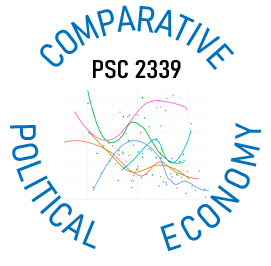Lecture 1
Polanyi’s Great Transformation
Emmanuel Teitelbaum
Overview
Polanyi’s Obejctives
- Explain rise of fascism, political instability and war
- Advance an argument about negative effects of economic liberalism
- Provide an alternative vision of the economy’s place in society
- Defend market regulation as not inherently “leftist”
The Self-Regulating Market
The “Invisible Hand”
- 19th century economic liberalism
- Ricardo/Smith
- An economy directed by market prices and nothing but market prices
- Polanyi calls it a “dangerous fantasy”
- Tremendous amount of bureaucracy/governance required to maintain free markets
State of Nature I
- For Smith, our nature is to “truck, barter and trade”
- For Polanyi, we are communal by nature
- Markets have always played some role in society but not the dominant role
- Importance of ethnography
- Evidence-based approach
- Not just a rhetorical device
State of Nature II
- Trobriand Islanders (Papua New Guinea)
- People motivated by status more than money
- Money is a means to and end
- Money not that relevant for distribution
- Reciprocity
- Redistribution
- Householding
Discussion
- What is your view of the state of nature?
- Is it more similar to Karl Polanyi’s or Adam Smith’s?
19th Century Panics
Discussion
- Polanyi argues that economic liberalism generates political instability
- Looking at the graph, do you see the connection?
- Can you also find evidence challenging Polanyi’s view?
The Gold Standard
- Origins (1821-1870s): UK first adopted it (1821), followed by other major economies
- Purpose: Ensured monetary stability, prevented inflation, and facilitated international trade
Phases & Decline
- Classical Gold Standard (1870s–1914): Stable but rigid
- WWI & Interwar Period (1914–1930s): Suspension, economic instability, and deflation
- Bretton Woods (1944–1971): USD pegged to gold; collapsed in 1971 under Nixon
Why It Ended
- Economic Rigidity: Limited crisis response
- Deflation & Trade Imbalances: Led to recessions
- War & Government Spending: Required more flexibility
- USD as Reserve Currency: Fixed peg unsustainable due to dwindling gold reserves
Legacy: No country uses it today, but debates over its return persist.
The “Double Movement”
Small Groups
- Review the concept of the double movement as it is presented in Chapter 11 of The Great Transformation
- What does Polanyi mean by a “movement” and a “counter-movement”?
- Who are the actors involved?
- Who is affected by this “movement”
- What does the “counter-movement” entail?
- Try using ChatGPT to help interpret the text
Description of Double Movement
- Movement: expansion of liberalism and self-regulating markets
- Counter-movement: reaction of society against dislocation caused by markets
- New regulations
- Purpose is to shelter land, labor and the money supply against “devastating effects” of policies used to sustain self-regulating markets
- Importance of class dynamics: winners and losers
Who are the Opponents of Liberalism?
- Not a unified, hegemonic left or an anti-liberal ideology
- Responses are rather piecemeal
- Regulation arises in many areas
- Across many countries
- In response to similar problems
- Regulation is a result of liberalism’s failure, not its cause
Small Groups
- Can Polanyi’s theory of the “double movement” be applied to contemporary politics?
- Provide at least two concrete examples to support your view
- Be sure to identify
- The “movement”
- The “countermovement”
- The actors involved, e.g. winners and losers
- Be sure to identify
The Birth of Liberalism
Elements of Liberalism
- Unfettered labor market
- Cheap labor for industry
- Gold standard
- Facilitated trade
- Kept prices in check
- Free trade
- Industrialists/traders wanted to access raw materials
- Facilitated by the gold standard
The Gold Standard (1879-1973)
- Pegging the value of the dollar to gold
- Problems
- Deflationary: could not print money in excess of gold supply
- Led to dramatic boom-bust cycles
- Reforms
- 1931: Roosevelt ends gold standard domestically
- 1971: Nixon ends Bretton Woods
Small Groups
- Review Chapter 12
- What are some misconceptions about the origins of liberalism?
- When and why did liberalism actually emerge?
- How does the “double movement” apply to the birth of liberalism?
- What are some elements of the “counter-movement”?
- Utilize ChatGPT to help interpret the text
Where Did Liberalism Come From?
- Does not date back to Smith or Ricardo
- These thinkers were ahead of their time
- Emerged out of class politics following industrial revolution
